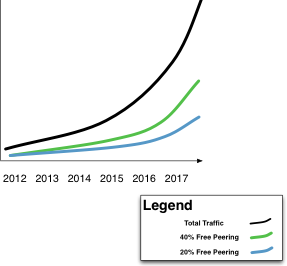Ask Dr. Peering




Q:
DrPeering –
We are a large and aggressively growing content provider and we are curious about whether all of this Internet Peering stuff applies to us as much as it does to Internet service providers.
Wile E. Coyote, Acme Ball Bearing Company
Albuquerque, NM
A:
Wile E. -
Thanks for the question... And the short answer is YES! The next generation of content providers are in fact starting to peer massive quantities of traffic now. As always, peering value comes down to traffic volume and performance benefits.
As to the financial value of peering, we have two questions:
How much traffic can you peer away for free?
And how much does it cost to peer?
These have always been the questions, and here is the Peering vs. Transit analysis graph to help answer your question.

As you can see from this graph, the cost of Internet Peering decreases as you send more and more traffic across the peering infrastructure. If you only have a few megabits-per-second of traffic to peer, then peering may indeed be the more expensive option. However, if you have 3 or 4 Gigabits per seconds of traffic that you could peer away for free, then peering is cheap enough that you end up near the Peering Break-Even Point.
The Peering Break-Even Point is the point where the cost of Internet Peering exactly equals the cost of Internet Transit, so a network operator is financially indifferent between peering or simplifying buying Internet Transit. Beyond the Peering Break-Even Point, the network operator is better off to peer their traffic away since the cost of doing so are completely covered by the cost savings from not sending that traffic through the metered transit service.
The mathematics are the same for content providers, ISPs, CDNs, mobile operators, etc. It really comes down to the questions of how much traffic you can peer away for free, and how much does it cost to do so. The Internet Exchange Point operator can facilitate making contacts to establish those peering sessions.
Of course, content providers are not usually peering to save money. Around the world, content providers peer primarily to improve the end-user experience. Google, Microsoft, Electronic Arts, etc. all peer substantial amounts of traffic off of their own global backbones. These network investments were made to improve the end-user experience. The fact that Microsoft might save a few million dollars per year by peering is immaterial to their bottom line, but the active happy user bases is critically important.
I should point out also that content providers face an uphill battle when entering the Internet Peering Ecosystem. First, content providers look an awful lot like customer prospects to many target ISPs. Second, the balance of power has always favored the access networks, your target peers. Third, Internet Service Providers may require infrastructure and services that content providers do not already have. For example, many ISPs require that all their peers have a national backbone with three interconnect points, a 24/7 Network Operations Center, a network trouble escalation process, and a sufficiently talented network backbone staff. For many content providers, this infrastructure does not already exist.
Best of luck !

Q:
DrPeering –
How do I know if I will have enough traffic to peer away for free before I spend the capital and build into an exchange point?
Hasan Chop
A:
Hasan - Thanks for that question.
What many peering coordinators do is attend peering forums. The goal here is to meet face-to-face as many peering coordinators as possible, to get a sense about who would peer and why they would peer. Many peering coordinators will look at a net flow analysis to identify the most attractive peers, that is, those that have a lot of traffic going to or coming from their network. In many cases however, people use intuition to identify potential peers. For example, a content provider might guess that a lot of their traffic ends up being delivered to Comcast customers. In any case, you might find peering coordinators putting together a “Top 50 Target Peers” list before heading off to a peering or Internet operations forum.
Next, the peering coordinator might associate the amount of traffic that one can peer with each of the networks in the target list, and then assess the likelihood of successful peering based on their peering inclinations. This market intel helps in setting priorities, in setting internal expectations, and it helps in preparation for the conversations with the target peers. For example, a typical opening peering conversation might be,
“Hi, I represent AS 54321 and we have about 350 Mb per second of traffic to peer with you, and I see that we are both peering at the DE-CIX. We are growing at 75% per annum, and we would like to peer with you at these 3 mutually deployed sites...”
Having these statistics handy allows the target to assess the potential significance of the peering sessions.
In some cases, it is helpful to understand the target network’s goals. For example, some access networks advertise the performance benefits of their network to reach specific content providers. They may even specifically advertise how fast their network can reach one of your content provider web sites. This is valuable information to have when you approach a target peer since you can offer to improve the performance through a network interconnect. If performance is important, then lead with performance.
Finally, I tell my clients
“You will never be 100% certain in advance that you will be able to peer away enough traffic to make it financially worthwhile.”
Then I point out is that the benefits are not cumulative – they are compounded.
That is, by obtaining peering with networks today, we reap the benefits of peering not just for today, but for tomorrow and into the foreseeable future.
This is because:
1.Once established, peering tends to stay in place. So this makes peering cumulative.
2.Internet traffic tends to grow as shown in the graph, so the value of peering 20% of your traffic away for free is compounded over the years.
3.No one plans on stopping at 20% peering – everyone plans to reach at least 40% peering, so this compounds even further the benefits of peering.
On top of this of course, 20-40% of traffic will be delivered with lower latency, and less packet loss, so this subset of your customer base will from here forward will have a better end-user experience. So I tell my clients,
“When you are about 80% of the way there, go for it. Waiting for that last 20% won’t buy you that much.’

This article is about content provider peering.
First, does peering apply to content providers?
Second, how do you know in advance how much traffic you can peer?
Content Provider Peering
July 28, 2012


The 2014 Internet Peering Playbook
In Print
and for the Kindle:
The PDF, ePub and
.mobi files are
also available as a
perpetually updated
DropBox share:
Price: $9.99
and in French!
The 2013 Internet Peering Playbook
also available for the Kindle:
and the ipad






